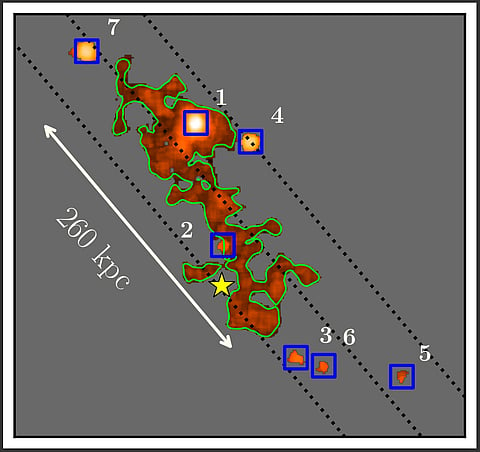

“The number of galaxies detected in such a small volume of the universe is 10 times higher than what we typically observe in surveys at this epoch,” said Eshita adding that moreover, their spatial distribution across the sky revealed a rare alignment, which strongly suggests the presence of a larger, underlying filamentary structure. The 10-hour-long deep observations with MUSE enabled us to search for and detect extended Lyman-alpha emission along the filamentary structure.”A team of international scientists have discovered a Cosmic Web Filament from 11.7 billion years ago, this length compares 10 times the size of the Milky way’s stellar disk and one-third of the distance between the Milky way and Earth’s nearest neighbour Andromeda.
The team was led by Eshita Banerjee, a PhD scholar at the Inter University Centre for Astronomy and Astrophysics (IUCAA), Pune and her supervisor Sowgat Muzahid, discovered it by using the Very Large Telescope (VLT) in Chile, operated by the European Southern Observatory (ESO).
To detect this elusive structure, the researchers directed their telescope toward the high-redshift quasar Q1317–0507. By analyzing the high-resolution spectra of the quasar, they identified a neutral hydrogen-rich region, known as a partial Lyman Limit System (pLLS), at a redshift of z ~ 3.6. This region exhibited an exceptionally low proportion of heavy elements, with a metallicity 10,000 times lower than the solar neighborhood, aligning with theoretical predictions for pristine cosmic filaments. In complementary observations with the Multi-Unit Spectroscopic Explorer (MUSE) on the VLT, the team identified seven Lyman-alpha emitting galaxies at the same redshift.
“These nebulae are typically observed around luminous quasars, whose intense radiation illuminates the surrounding gas. However, none of the galaxies detected in this study exhibit quasar-like properties, making this discovery truly exceptional,” stated Sowgat. “While the precise mechanism(s) driving the extended Lyman-alpha emission remains unclear, we propose that recombination radiation, powered by the radiation fields of the detected galaxies, is the primary contributor,” he added.
The research team has effectively demonstrated the unique power of combining complementary information on cosmic web filaments through both emission and absorption line studies for the first time. Absorption line studies offer crucial insights into the primordial nature of filaments detected in emission. This research was recently accepted by the prestigious Astrophysical Journal Letters https://iopscience.iop.org/article/10.3847/2041-8213/ada94f
“This discovery also demonstrates the importance of international collaborations that enabled us to leverage the ESO facilities,” said Muzahid. The research was conducted in collaboration with scientists from Leiden University (Netherlands), University of Milan-Bicocca (Italy), and the University of Michigan (USA).
